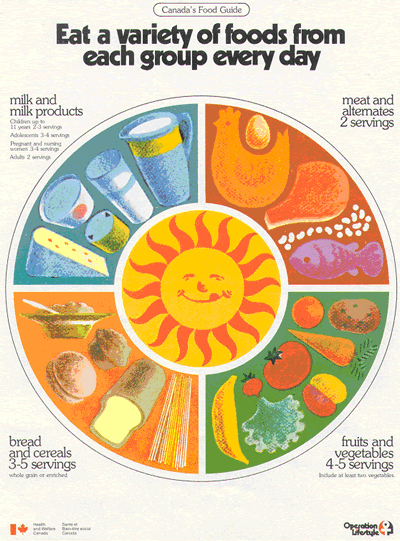This past Tuesday, the Canadian government unveiled its new food guide. This is the feature image from it.

Yummy, right?
At first glance, this new guide might not seem like a big deal. Obviously, we weren't expecting to see a big pile of cheeseburgers, candy bars, and potato chips. Canadian health experts think we should eat lots of fruits and veggies. Duh.
But this guide is actually a huge change in how the government has suggested that we eat our meals. How so? And why? Let's check it out.
The big four
Most countries release these guides to help the public make healthy choices about what they eat. In Canada, they get updated every 10 to 15 years or so, but for a long time they were fairly predictable.
For example, here's the food guide for 1977.

Here's 1992.

And finally, 2007.

Notice any patterns? The biggest one is that they all feature four main food groups:
- Grains and cereals
- Fruits and vegetables
- Milk and dairy products
- Meat, fish, and alternatives
For decades, getting a balance from these four groups was the backbone of the food guide. There are subtle changes from guide to guide, but generally the big four rules the guide, year after year after year.
Power trio
Now take another look at the new 2019 food guide. The plate is now divided into three recommended groups.
- Fruits and vegetables
- Protein foods
- Whole grains
The fruits and veggie dominate half the plate. Grains used to be full of baked goods but now bread is barely featured, replaced by whole grain. Proteins still feature meats, but this is balanced by chickpeas, beans, seeds, nuts, and tofu. And dairy? It's barely seen at all, except for a dollop of yogurt.
What's going on?
Rise of the plants
In the past decade, plant-based options such as nut milks and yogurts, chia seeds, and tempeh have become more common in North American diets. (Getty Embed)
In a nutshell (get it?), the guide is trying to emphasize plant-based food more than ever before. As it puts it: "Choose protein foods that come from plants more often."
This isn't necessarily about turning everyone into a vegetarian. But for years, both health and environmental experts have stressed that people eat too many animal products. This guide is hoping to make people more comfortable with the idea that a plant-based meal is more than something to do when you're out of options—it's something that we should do regularly.
And as for dairy? In this guide, it just another source of animal-based protein, like eggs or chicken. Healthy? Sure. But just one of many protein options.
It's a lifestyle
Let's hang out! Canada wants us to enjoy our meals together more. (Getty Embed)
Another change? If you look at the old food guides, you'll see that they were also quite specific about how many servings of each food group people needed to eat each day. The new food guide has none of that.
Instead, it emphasizes how we prepare and eat our food. We should cook at home more instead of eating out or ordering in. We should eat meals more in groups and as a family. And we should take our time eating, not rush through the meal.
And the reaction is ...
People are very personal about their food choices. And there are more diets out there than you can shake a stick at. Even some health experts disagree somewhat. All of this makes creating a food guide that pleases everyone a real challenge.
This guide also features far less dairy and meats than in the past. This choice could upset some farmers who specialize in raising these types of food. And even people who agree with the choices are concerned that fresh veggies and whole grain items are too expensive to serve on a regular basis.
What do you think of the new guide?
 Hope you like your fruits and veggies! (© Nitsuki - Dreamstime.com)
Hope you like your fruits and veggies! (© Nitsuki - Dreamstime.com)










I am a vegetarian, so I am glad the government is not just saying “Eat meats”
it is fun
hi grayson
????????????????????????????????????????????????????????????????????????????????????????????????????????????????????change the gide
me too!